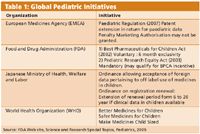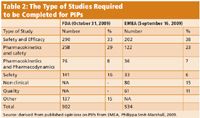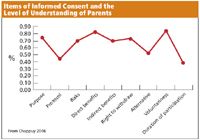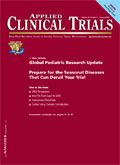Pediatric Trials: A Worldwide View
Applied Clinical Trials
Global research in children affects industry and the trial environment.
It has been three years since the introduction of the European Pediatric Regulation,1 just one of several global initiatives focusing on children's health. The Regulation has the stated aim to protect children and improve their health through the conduct of formal clinical research in order to increase access to innovative medicines and to derive data to guide the prescriber in the use of medicines in the pediatric population.

Similar objectives are voiced by organizations including the World Health Organization (WHO), the U.S. Food and Drug Administration (FDA), and other competent authorities who have also been trying to stimulate clinical research in children and encourage the conduct of ethical, high-quality clinical trials to facilitate the timely licensing of medicines, with relevant formulations, in order to protect children from inappropriate and often off-label use of drugs licensed for adults or from exposing children to poor quality drugs.
Inevitably, these measures have had an impact on the pharmaceutical and biotechnology industries' research and development priorities and the international clinical trial environment.
Most medicines given to children are used off-label.2 In hospital pediatric wards this is around 45%,3 and in the neonatal intensive care setting this can be as high as 90%. The experience gained in this way is rarely incorporated into clinical practice guidelines or medicinal product labelling. This practice, which often utilizes a simple extrapolation of dose from adult experience based on body weight or body surface area, represents a potential safety hazard by causing adverse events through overdosing, inefficacy through under dosing and the use of inappropriate formulations or substandard medicines.
This is because children differ developmentally, psychologically, physiologically, and hormonally from adults. They also experience different health problems or disease patterns than adults. The response of children to drugs may differ for these reasons and, moreover, genetic factors will play a role in the response of a child to drugs.4
Regulations and initiatives
In the United States, legislation in place since 1979 required pediatric data in labelling for medicinal products. Under the Best Pharmaceuticals for Children Act (BPCA),5 which was made law in 2002, an incentive of six months marketing exclusivity can be granted for products studied in response to a written request for pediatric studies, and is further supported by the Pediatric Research Equity Acts (PREA), which first appeared in 1998 as the Final Pediatric Rule, and mandates pediatric studies.6
The Pediatric Regulation in Europe was preceded by the ICH Guidance 11 for conducting studies in the pediatric population.7 It also obligates pharmaceutical manufacturers to conduct clinical studies in children in accordance with an agreed Pediatric Investigational Plan (PIP) in return for six-month patent protection.

This global representation of the number of pediatric studies worldwide are based on 2008 numbers from "Trends in the Globalization of Clinical Research," by F. A. Theirs, in Nature Reviews Drug Discovery.
The Regulation is accompanied by guidance documents on various themes in pediatric research (risk management planning,8 ethical conduct of pediatric studies,9 formulations of choice for the pediatric population,10 the role of pharmacokinetics in pediatric drug development,11 and the investigation of products in the neonatal population.12
There is concern that the incentives provided by the Regulation are potentially insufficient to offset the cost of developing drugs for use in children. The European Federation of Pharmaceutical Industries and Associations has voiced this concern,13 whereas generic manufacturers would prefer to have earlier access to drugs and see a shorter protection period. For marketed products, the window of opportunity is limited due to patent expiry and the cost of a pediatric development may deter companies investing in variations including new indications, formulations, and routes of administration. The House of Lords in the UK also raised the point that prolongation of the patent protection would result in increased National Health Service costs of between £30 million and £120 million per year ($50 million to $200 million) due to the higher price of branded products compared to generics.14
The level of experience of clinical investigators in conducting research in children meant for regulatory submissions—in ethical and consent issues—together with a relative lack of experience of Ethical Committees in assessing pediatric trials can also impede the execution of the studies. Probably a better public awareness of the need for research in children would increase the level of parental commitment for the participation of children in trials, and a better understanding of the ethical and regulatory framework will reassure parents and carers that safeguards are in place to protect their child from unnecessary exposure to experimental drugs.

Table 1: Global Pediatric Initiatives
Global collaboration
Harmonization of the principles of clinical research (ICH) has been achieved across the three major global territories of Japan, the United States, and Europe, but pediatric regulations or provisions are not yet harmonized or even in place across all territories.
The EMEA has contacts with main European pediatric societies and has a collaboration with the National Institutes of Health (NIH) in the United States, the WHO, the Japanese National Center for Child Health and Development (NCCHD), and existing research networks and centers and it collaborates with family/patient organizations.
Of significance has been the establishment of a close collaboration between the EMEA and FDA involving exchange of information with respect to product-specific pediatric development, general issues in pediatric development, safety issues such as reporting of adverse drug reactions (ADR) in children, and the exchange of statistics from ADR databases. There is mutual observation of internal pediatric meetings, monthly (and as needed) teleconferences, exchange of the monthly listing of pertinent applications and EMEA/FDA decisions, and upon request exchange of final EMEA and/or FDA documents.

Table 2: The Type of Studies Required to be Completed for PIPs
In Japan, the Ministry of Health, Welfare and Labor has established pediatric drug therapy review meetings in order to collect and evaluate literary evidence relating to the efficacy and safety of drug prescriptions in children. Two ordinances provide for the acceptance of pediatric data from off label use outside Japan and for an extension to the review period for medicines where pediatric studies have been performed. Since November 2009, a pediatric cluster has been developed in the Japanese Ministry of Health, Welfare and Labor to observe the monthly teleconferences between the FDA and EMEA.

Items of Informed Consent and theLevel of Understanding of Parents
These activities, summarized in Table 1, promise to harmonize the regulations and requirements that surround clinical studies in children from a regulatory perspective and avoid the unnecessary duplication of studies in children and unify the approach to product-specific pediatric development.
Legislation, initiative impact
In the United States, as of October 31, 2009, the pediatric legislation has resulted in 950 written requests (574 requests from industry and 376 issued by FDA) for 902 pediatric studies, involving more than 56,000 patients. So far studies conducted under the various regulations have recruited over 85,000 patients. Three hundred and thirty three additional labelling changes on safety, efficacy, dosing, and unique risks in children have been achieved for 156 active moieties and 163 drugs have been granted exclusivity.
By the November 13, 2009, meeting, the Pediatric Committee (PDCO) at the EMEA reported that they had received 614 validated PIP/waiver applications covering 946 indications [see Table 2]. The majority of 66% were for products not yet authorized, 31% were for variations to an existing license, and only 3% represented off-patent products. To date, 201 positive decisions have been made on PIPs including deferrals, 120 on full waivers, and 17 negative opinions have been given. Now increasing numbers of modifications to previously agreed upon PIPs are being made with 51 modifications approved up until November 13, 2009. In PIPs approved until September 16, 2009, 520 clinical studies were required to be completed.
The complexity of studies conducted in children has increased, with efficacy and safety studies representing 40% of all pediatric studies conducted in 2006 compared with 25% in 2000.15 Consequently, the cost to conduct clinical studies has increased, where the average cost to comply with a written request has risen from $3.93 million in 2000 to $30.82 million in 2006. The time taken to complete clinical studies in children increased as well, from 22.8 months in 2000 to 39.7 months in 2006—almost doubling.16
Moreover, the economic return on clinical trials performed under the pediatric exclusivity program in the United States was variable, found to be between -$8.9 million to $507.9 million.15 Therefore, not all development programs have been offset by the rewards provided by BPCA and in the future the possible lack of return on investment may in fact deter companies from embarking on clinical research in children with new or established drugs.
Industry and trials impact
The many pediatric initiatives have had a significant impact on the pharmaceutical and biotechnology industries. In particular, pediatric development should now be provided for earlier in the development planning process and in parallel with adult development. This requires early consideration of preclinical testing, particularly in juvenile animal models, formulation development, and the acquisition of pediatric competency either within the company or through the use of external academic and specialist support such as CROs.
Due to the unique characteristics of the pediatric population different approaches to clinical trial design are required. Adaptive designs, stratification, and cross over designs are more commonplace, and in pharmacokinetic work pharmacodynamic/pharmacokinetic modelling techniques and sparse sampling pharmacokinetic studies are often used.11 The age of the patient may dictate blood sampling limits and the use of invasive tests. Innovative techniques such as micro assays, dry blood spot, and the use of other bodily samples and noninvasive investigation techniques are often applied.
Disease demographics, language, religion, culture, investigator–patient relationships, clinical management practices, and access to health care and medicines are all aspects of international trials that require planning in the pediatric setting. Without taking these into account, recruitment and retention may not be successful.
There are issues in conducting clinical studies in children in emerging territories such as the accessibility to primary and secondary care and the existence of health records, which are important for eligibility confirmation and source data verification. In these regions, the existence of regulatory and ethical committee frameworks with experience in pediatric studies is not often robust.
The competition for patients is fierce since recruitment of children into clinical studies is more difficult than for adult studies and more studies are needed. Provisions to avoid unnecessary duplication of clinical studies in children such as the collaboration between the FDA and EMEA are not yet fully effective, with written requests and PIPs repeating or requiring different studies.
Increasingly, clinical studies are being conducted in new territories to achieve recruitment targets and overcome hurdles presented by the competition for patients in conventional countries such as the United States and Western Europe. There has been a significant increase in the number of all studies conducted in these nonconventional regions.17
Recruitment and retention
Of crucial importance in the recruitment and retention process is that of obtaining informed consent from parents (one or both) and assent from the child. This requires the provision of good information, trained staff with pediatric experience, and child friendly environments. An understanding of the motivation of parents in allowing the participation of their child in a clinical study is also helpful.
The provision of adequate information to parents of legal guardians is important in obtaining consent and the provision of age appropriate information to the child is equally important in obtaining assent. There are ethical considerations when conducting studies in diseases where a treatment is already available, where placebo control is relevant, and in an emergency setting. All of these affect the willingness to participate in clinical research.
Several studies have investigated the motivation of trial participants and have assessed the ability of parents to understand and memorize information given to them in the consent process. Parents asked to enroll their child in a clinical oncology or HIV study understood the aims, risks, benefits, and voluntariness of the study better than alternative treatments, procedures, and duration of participation18 [see figure previous page].
In a similar study, mothers of children asked to participate in a prospective asthma study reported that they were motivated by altruism and the possibility for regular check-ups in the clinic. Voluntariness was also important.19 Forty-four parents or guardians of children participating in a different asthma study reported that the most important motives for them was learning about their child's illness and helping medical knowledge.19
Finally, in a tertiary care emergency setting, 136 family caregivers were asked about their perception of clinical research. Eighty-one percent agreed that physicians should do research in children, but 18% felt that physicians cared more about the research than the patients. Parents were significantly more unlikely to endorse research in an emergency setting than in a nonspecified setting.20
Recruitment techniques that respond to these perceptions and expectations work best with adequate and appropriate information on clinical research in children. The disease and risk benefit of the trial together with parent and child friendly environments and adequate time for consideration are important in recruitment and retention. Also, transportation availability to investigative sites, facilities, and communication in multilingual and multiculture populations will all affect the quality and timeliness of a trial.
Summary
In summary, pediatric research is increasing in volume and has become a global phenomenon. The special challenges of clinical studies demand careful planning and resourcing if the goals of the initiatives from regulators, governments, and health organizations are to be achieved. Integration of pediatric drug development in the planning process and assessment of the return on investment is important.
The creation of PIPs requires an understanding of the clinical needs in children and what studies are feasible. Harmonization of regulatory requirements will hopefully lead to a reduced clinical trial burden and an avoidance of the overexposure of children to untested medicines. Clinical study risk assessment and contingency planning and the careful placement of the studies taking into account cultural, regulatory, and clinical practice differences between countries will ultimately determine the success of pediatric development.
Philippa Smit-Marshall, MD, FFPM, FICR, is Vice President for Europe and Asia Pacific, Medical Affairs, at PharmaNet BV, Storkstraat 18-22, 3833 LB Leusden, The Netherlands, email: psmit-marshall@pharmanet.com.
References
1. Regulation (EC) No 1901/2006 of the European Parliament and of the Council of 12 December 2006 on Medicinal products for paediatric use and amending Regulation (EEC) No 1768/92, Directive 2001/20/EC, Directive 2001/83/EC and Regulation (EC) No 726/2004 (Official Journal L378,27/12/2006, 1-19).
2. E. Tan, N.E. Cranswick, C.R. Rayner, C.B. Chapman, "Dosing Information for Pediatric Patients: Are They Really Therapeutic Orphans?" Medical Journal of Australia, 179 (4) 195-198 (2003).
3. S. Conroy, I. Choonara, P. Impicciatore et al., "Survey of Unlicensed and Off-Label Drug Use in Paediatric Wards in European Countries, British Medical Journal, 320, 79-82 (2000).
4. A.E. Guttmacher and F.S. Collins, "Inheritance and Drug Response," New England Journal of Medicine, 348 (6) 529-537 (2003).
5. Best Medicines for Children Act 2002 (BPCA) Public Law 107-109.
6. Pediatric Research Equity Act (PREA) Public Law 108-155.
7. International Conference on Harmonisation Tripartite Guideline E 11: Clinical Investigation of Medicinal Products in the Pediatric Population, CPMP/ICH/2711/99.
8. CHMP Guidelines on conduct of Pharmacovigilance for Medicines used by the Paediatric Population, EMEA/CHMP/PhVWP/235910/2005.
9. Ethical Considerations for Clinical Trials Performed in Children. Recommendations of the Ad Hoc group for the development of implementing guidelines for Directive 2001/20/EC. Draft for Consultation 6 October 2006.
10. Reflection paper, Formulations of Choice for the Paediatric Population EMEA/CHMP/194810/2005.
11. Guideline on the Role of Pharmacokinetics in the Development of Medicinal Products in the Paediatric Population, EMEA/CHMP/EWP/147013/2004.
12. Guideline on the Investigation of Medicinal Products in the Term and Preterm Neonate, EMEA/267484/2007.
13. EFPIA Views on the European Commission's Proposal for a Regulation on Medicinal Products for Paediatric Use.
14. http://www.efpia.org/4_pos/paediatrics0405.pdf.
15. House of Lords of the United Kingdom, HL 101 Session 2005-2006.
16. C.P. Milne, Pediatric Study Costs Rose Substantially from 2000 as Complexity Grew, Tufts Centre for the Study of Drug Development Impact Report, 9 (2) 2007.
17. J.S. Li, E.L. Eisenstein, H.G. Grabowski et al., "Economic Return of Clinical Trials Performed under the Pediatric Exclusivity Program, Journal of the American Medical Association, 297 (5) 480-488 (2007).
18. H. Chappuy, F. Doz, S. Blanche, J.C. Gentet, G. Pons, J.M. Treluyer, "Parental Consent in Paediatric Clinical Research," Archives of Disease in Childhood, 91, 112-116 (2006).
19. A. Gammelgaard, L.E. Knudsen, H. Bisgaard, "Perceptions of Parents on the Participation of their Infants in Clinical Research," Archives of Disease in Childhood, 91, 977-980 (2006).
20. J.D. Rothmier, M.V. Lasley, G.G. Shapiro, "Factors Influencing Parental Consent in Clinical Research," Pediatrics, 111 (5) 1037-1041 (2003).

Improving Relationships and Diversifying the Site Selection Process
April 17th 2025In this episode of the Applied Clinical Trials Podcast, Liz Beatty, co-founder and chief strategy officer, Inato, discusses a number of topics around site engagement including community-based sites, the role of technology in improving site/sponsor relationships, how increased operational costs are impacting the industry, and more.